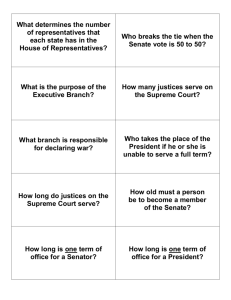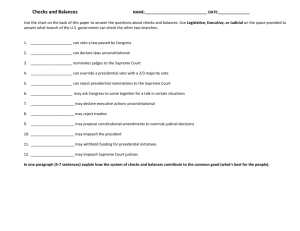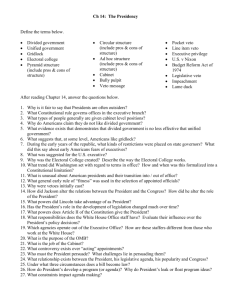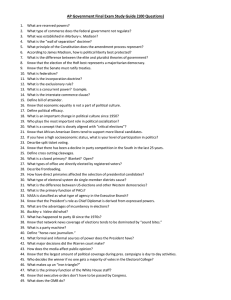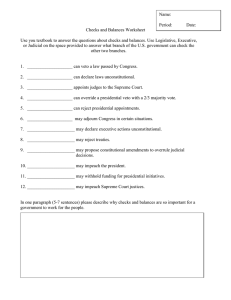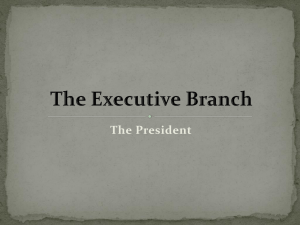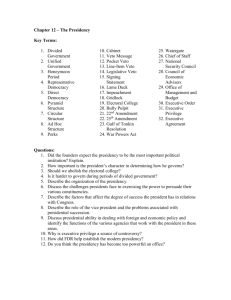The Top 20 Topics of AP Government
advertisement
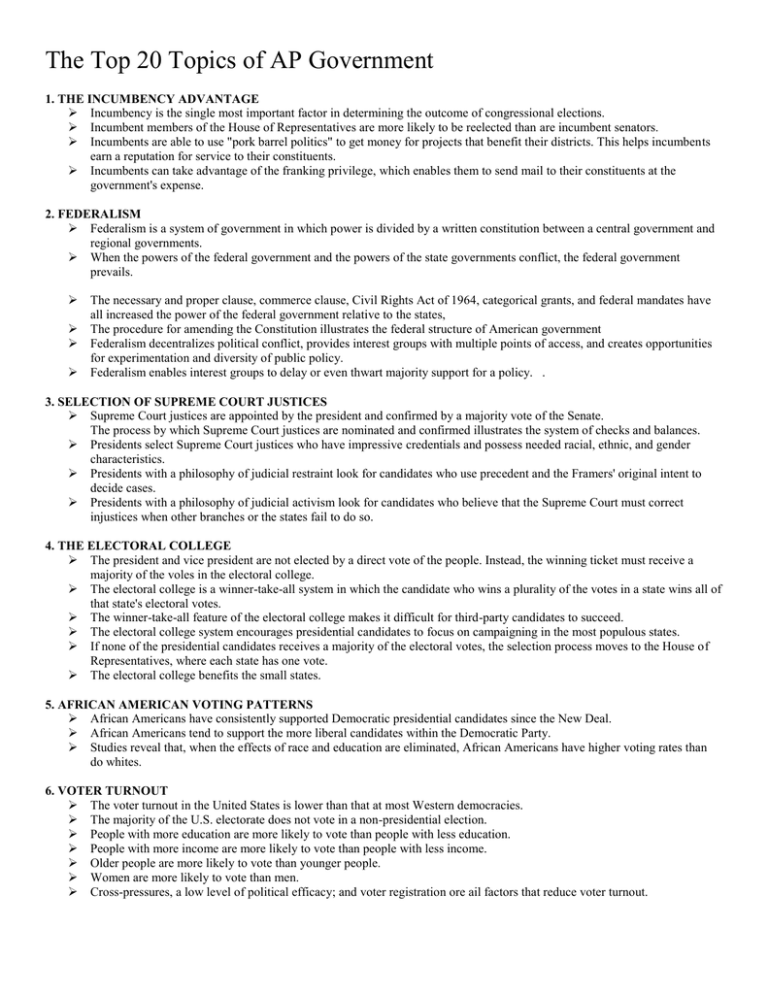
The Top 20 Topics of AP Government 1. THE INCUMBENCY ADVANTAGE Incumbency is the single most important factor in determining the outcome of congressional elections. Incumbent members of the House of Representatives are more likely to be reelected than are incumbent senators. Incumbents are able to use "pork barrel politics" to get money for projects that benefit their districts. This helps incumbents earn a reputation for service to their constituents. Incumbents can take advantage of the franking privilege, which enables them to send mail to their constituents at the government's expense. 2. FEDERALISM Federalism is a system of government in which power is divided by a written constitution between a central government and regional governments. When the powers of the federal government and the powers of the state governments conflict, the federal government prevails. The necessary and proper clause, commerce clause, Civil Rights Act of 1964, categorical grants, and federal mandates have all increased the power of the federal government relative to the states, The procedure for amending the Constitution illustrates the federal structure of American government Federalism decentralizes political conflict, provides interest groups with multiple points of access, and creates opportunities for experimentation and diversity of public policy. Federalism enables interest groups to delay or even thwart majority support for a policy. . 3. SELECTION OF SUPREME COURT JUSTICES Supreme Court justices are appointed by the president and confirmed by a majority vote of the Senate. The process by which Supreme Court justices are nominated and confirmed illustrates the system of checks and balances. Presidents select Supreme Court justices who have impressive credentials and possess needed racial, ethnic, and gender characteristics. Presidents with a philosophy of judicial restraint look for candidates who use precedent and the Framers' original intent to decide cases. Presidents with a philosophy of judicial activism look for candidates who believe that the Supreme Court must correct injustices when other branches or the states fail to do so. 4. THE ELECTORAL COLLEGE The president and vice president are not elected by a direct vote of the people. Instead, the winning ticket must receive a majority of the voles in the electoral college. The electoral college is a winner-take-all system in which the candidate who wins a plurality of the votes in a state wins all of that state's electoral votes. The winner-take-all feature of the electoral college makes it difficult for third-party candidates to succeed. The electoral college system encourages presidential candidates to focus on campaigning in the most populous states. If none of the presidential candidates receives a majority of the electoral votes, the selection process moves to the House of Representatives, where each state has one vote. The electoral college benefits the small states. 5. AFRICAN AMERICAN VOTING PATTERNS African Americans have consistently supported Democratic presidential candidates since the New Deal. African Americans tend to support the more liberal candidates within the Democratic Party. Studies reveal that, when the effects of race and education are eliminated, African Americans have higher voting rates than do whites. 6. VOTER TURNOUT The voter turnout in the United States is lower than that at most Western democracies. The majority of the U.S. electorate does not vote in a non-presidential election. People with more education are more likely to vote than people with less education. People with more income are more likely to vote than people with less income. Older people are more likely to vote than younger people. Women are more likely to vote than men. Cross-pressures, a low level of political efficacy; and voter registration ore ail factors that reduce voter turnout. 7. DIVIDED GOVERNMENT Divided government occurs when the presidency and Congress are controlled by different parties. Divided government heightens partisanship, slows. the legislative process, and contributes to the decline in public trust in government. Presidents attempt to overcome the problems posed by divided government by using the media to generate public support, threatening to veto objectionable legislation, and building coalitions with key interest groups. B. POLITICAL ACTION COMMITIEES (PACs) Business PACs have dramatically increased in number since tile 19105. PACs play' a particularly significant role in supporting incumbent members of the House of Representatives. The amount of money that PACs can directly contribute to an individual candidate is limited by law. 9. THE VETO POWER The system of checks and balances gives the president the power to veto a bill and Congress the power to override a presidential veto. A pocket veto occurs when Congress adjourns within ten days of .submitting a bill to the president. The president can let the bill die by neither signing it nor vetoing it. Presidents often use the threat of a veto to persuade Congress to modify a bill. Congress is usually unable fa override a presidential veto. Most state governors can exercise a line-item veto. Congress passed the Line-Item Veto Act (1996) giving the president the power to veto individual items in major appropriations bills. In the case of Clinton v. City of New York (7998), the Supreme Court struck down the line-item veto as an unconstitutional violation of the principle of separation of powers. 10. THE PRESIDENT AND THE CABINET The president appoints cabinet heads subject to confirmation by the Senate. However, the president can fire a cabinet head without Senate approval. Cabinet members often have divided loyalties. Their loyalty to the president can be undermined by their loyalty to the institutional goals of their own department. Presidents often experience difficulty in controlling cabinet departments because they form iron triangles with interest groups and congressional committees. 11. PRESIDENTIAL PRIMARIES Presidential primaries hove weakened party control over the nomination process, In a closed primary, voters ore required to identify a party preference before the election and are not allowed to split their ticket. The Democratic Party now uses a proportional system that awards delegates based on the percentage of votes a candidate receives, Primary voters tend to be party activists who are older and more affluent than the general electorate, Front/loading is the recent pattern of states holding primaries in February and March to capitalize on media attention and to maximize their influence in the nomination process. 12. STANDING COMMITTEES AND THE SENIORITY SYSTEM Standing committees are permanent bodies that focus on legislation in a particular area. Thus, they promote specialized policy expertise among their members. All bills are referred to standing committees, where they can be amended, passed, or killed. Most bills are killed. Standing committees are divided into subcommittees, where the details of legislation are refined. In the past, committee chairs were chosen by a seniority system in which the majority party members with the most continuous service on the committee became the chair. Although chairs are now elected, most still tend to be senior members of the majority party. The system of standing committees is particularly important in the House of Representatives. The House Rules Committee plays a pivotal role. It places a bill on the legislative calendar, determines the type of amendment allowed, and allocates the time for debate. 13. THE FEDERALIST PAPERS . In federalist No. 10, Madison argued that political factions are undesirable but inevitable. Madison believed that the excesses of factionalism could be limited by the system of republican government created by the Constitution. Federalist No. 10 refuted the widely held belief that a republican form of government would work only in a small geographically compact territory. He argued that, a large republic such as the United States would fragment, political power and thus curb the threat posed by both majority and minority factions. 14. THE FOURTEENTH AMENDMENT AND SELECTIVE INCORPORATION The Fourteenth Amendment made African Americans citizens, thus voiding the Dred Scott decision. The Fourteenth Amendment's Due Process Clause forbids a state from acting in an unfair or arbitrary , way. Its Equal Protection Clause forbids a state from discriminating against or drawing unreasonable distinctions between persons. The doctrine of selective incorporation uses the Fourteenth Amendment to extend most of the requirements of the Bill of Rights to the states. 15. POLITICAL SOCIALIZATION Political socialization is the process by which political values are formed and passed from one generation to the next. The family is the most important agent of political socialization. Parents usually pass their party identification to their children. 16. CRITICAL ELECTION A critical election takes place when groups of voters change their traditional patterns of party loyalty. Critical elections trigger a party realignment in which the minority party displaces the majority party, thus ushering in a new party era The presidential elections of 1800, 1860, 1896, and1932 were all critical elections that transformed U.S. politics. 17. THE SELECTION OF SUPREME COURT CASES Most of the cases on the Supreme Court's docket are derived from the High Court's appellate jurisdiction. Nearly all appellate cases now reach the Supreme Court by a. writ of certiorari. According to the Rule of Four, at least four of the nine justices must agree to hear a case. The Supreme Court refuses to hear most of the lower Court appeals. 18. THE MASS MEDIA The mass media play a key role in affecting which issues the public thinks are important. These issues usually reach the government's policy agenda. Horse-race journalism refers to the media's tendency to focus on polls, personalities, and sound bites rather than on in-depth analysis of key issues. 19. THE ARTICLES OF CONFEDERATION The Articles of Confederation established a decentralized system of government with a weak central government that had limited powers over the states. The Articles created a unicameral Congress that locked the power to levy taxes or regulate interstate trade. 20. THE ROLE OF STATE LEGISLATURES In the original Constitution, state legislatures chose U.S. Senators. As a result of the Seventeenth Amendment, senators are now elected by voters in each state. State legislatures have the power to determine the boundary lines of congressional districts. State legislatures can ratify constitutional amendments by a vote of three-fourths of the states.

